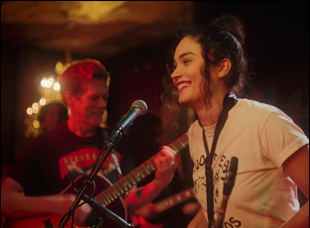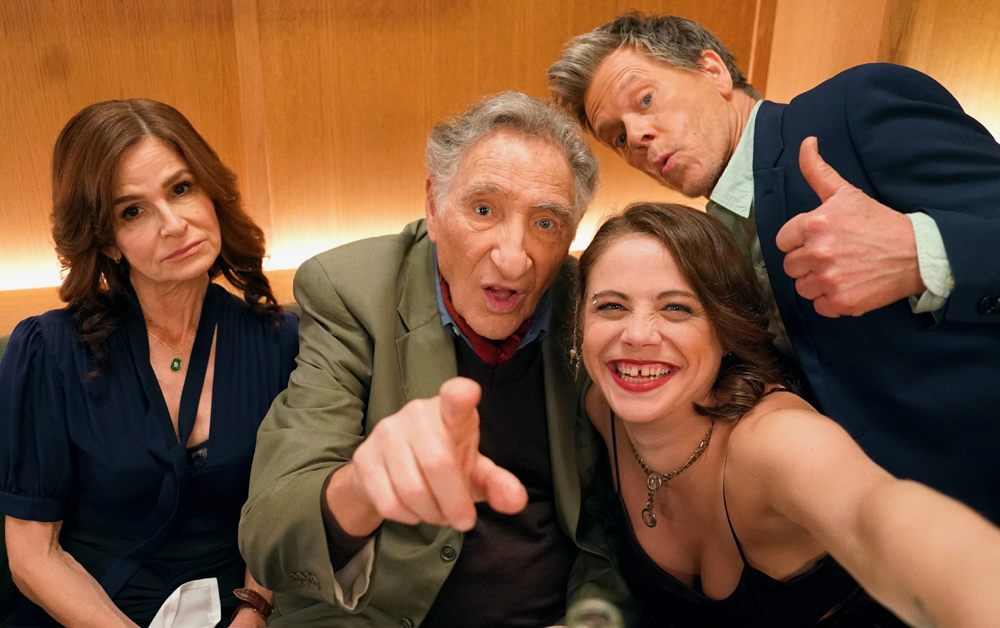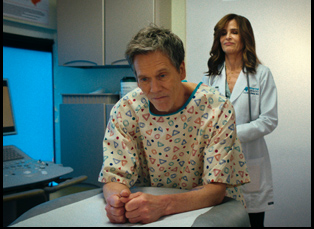Most of Michael J. Weithorn’s experience has not been in the film world, having found success in television where he first became a producer on “Family Ties” and eventually created “The King of Queens,” so it is only a little natural that he might feel out of place at a film festival.
“I’ve had a chance to meet other filmmakers, which I never would otherwise have had any chance to do and talk about what they’re in,” Weithorn said earlier this week as his second feature “The Best You Can” premiered at Tribeca. “These are career filmmakers – not like me, I’m a little bit of a dilettante going into this realm, but to just be part of that world is very exciting to me.”
Incidentally, Weithorn is living proof of his own longheld thesis that the universe is a better place when worlds collide, not only when “The Best You Can” shows off his formidable filmmaking chops, but that it tells the story of two people from completely different walks of life who find the road is easier ahead after they cross paths. Neither Stan (Kevin Bacon) or Cynthia (Kyra Sedgwick) could ever imagine a future in which they were intertwined, but then again they first meet when both have trouble seeing any for themselves, though for Stan, a retired cop who’s gone into private security, that’s largely a case of willful ignorance. He quite literally runs into Cynthia after scaring away a burglar from her home and the two have a reason to stay in touch when issues with his prostate prompt her to mention she’s a urologist, giving him the friends and family discount for treatment even though it would seem the gruff cop wouldn’t ever fall into either category for the refined doctor. Still, the two gradually find they have more to discuss than his bladder or the doorbell cam she considers installing for surveillance as they start texting each other deep into the night, not exactly flirting with one another but lending a compassionate ear to one another as Cynthia has a much older husband Warren (Judd Hirsch) dealing with the early stages of dementia and Stan is trying to reconnect with his daughter Sammi (Brittany O’Grady), a singer/songwriter, after spending a good deal of her childhood away from home.
As Weithorn showed in his lovely feature debut “A Little Help,” which starred Jenna Fischer as a hygienist quickly approaching the end of her rope in an unhappy marriage until an unexpected lifeline emerges, there’s considerable value in being pulled out of the bubble of one’s personal experience by someone well outside of it and while Stan and Cynthia dance around the fact that there clearly are sparks between them – and boy, are there when real-life couple Bacon and Sedgwick are playing them – their affection towards one another manifests itself in how their words of wisdom resonate as Cynthia is forced to consider placing Warren in a hospice in Cleveland and Stan tries to help Sammi kickstart her career on stage when she struggles for inspiration. Weithorn is able to bring the sharp humor he honed in TV writers rooms to make the film always feel as if it’s slightly better than real life but “The Best You Can” engages throughout when it’s so connected to the ways in which people go about their lives, fully realizing the most minor of characters can make an impact and envisioning fundamental decency as finding its way to the surface even as people can be so consumed with their own concerns.
While the film became a standout at Tribeca, Weithorn generously took the time to talk about how he pulled together Bacon and Sedgwick for their first on-screen collaboration in nearly two decades, getting to go wild with the film’s cinematography and music to make the story so vibrant and how he likes to let life into the frame at every stage of the process.
It was driven by the idea. I had done “A Little Help” and then I drifted back into TV world for a while. I was consulting on “The Goldbergs” and I did a very short-lived series on Fox, but I always keep a notebook of little tidbits of things that I think might be interesting as the germ of something in a film. I have dozens and dozens at any one time, and I started getting in that mode of [thinking], “I want to try to write another screenplay and do another film.” One of the things that survived from this notebook full of random musings was a dinner my wife and I had with a couple that was similar to Cynthia and Warren in that they had met when she was in her thirties and he was in his fifties, and [he was] a big superstar in his field. And when we had dinner with them, she was in her late 50s, he was in his 80s, and was clearly starting to slip, and she handled it very gracefully when he was on his phone and didn’t realize that it was on speaker. He’s like, “Why is it so loud?” and she reached over gently, and I said, “It’s got to be tough.” It just hit me, wow, that’s a tough thing for somebody to have somebody they love, the most important person in the world, all of a sudden start going away, essentially, and yet not literally dying, but just there, but less and less of the self.
That was intriguing to me, and then [I thought], “Okay, well, what happens? This woman’s going to be a little bit lost and lonely and want some companionship.” And I’ve always loved unlikely relationships that form. Ironically, it doesn’t sound like they’d be natural influences, but two films that I loved, loved, loved in my formative young years were “The Way We Were” and “Midnight Cowboy,” and I only realized after the fact that one of the things that grabbed me about those films was this idea of connections being formed that were unlikely, that were not people of the same group that would normally be thrust together, and the poignancy of that. So this felt like an opportunity to do something like that and create a fun character like Stan, this lovable loser that can’t get out of his own way and a little rough around the edges. I love writing characters like that. And it just took off from there.
Were Kyra Sedgwick and Kevin Bacon actually a package deal when you started thinking about casting this?
They weren’t a package deal at the beginning. It was certainly a thought that we had when I was casting, but you can’t approach the couple together because that gets very complicated. So we went to Kevin and he liked the script and was very interested and he suggested Kyra the first time I met him. Of course, Kyra would be on any short list for a role like this, but I had some concerns about about not her individually, but them as a couple. I just didn’t want it to be cutesy, like it’s like a big Instagram post, and for the film to be just an extension of their formidable persona as a couple. I wanted to just be a film that they are acting in. And as soon as I talked to both of them about it, it was so clear that that wasn’t a concern.
I didn’t know Kyra and never met her, but one concern I had was was “Okay, there’s a New York City urologist and Kyra Sedgwick has these gorgeous blonde curls, and that’s not the New York City urologist [to me], so [I thought] is she going to be attached to that? She going to fight to keep her look? Not at all. She was a very, very dedicated actress and she was really wanted to submerge into the character. And I said once I heard that and also got a sense of her just general intelligence about what she does, I thought, “This is going to be great.”
It seems like you can get a lot with a lot more because of that natural chemistry – there’s a sequence in the film where they’re texting with one another and they’re not interacting with each other in the same frame, but still there’s so much intimacy. Did it take much to bring to life because it becomes one of the most vibrant sequences?
Because texting has become the default mode of communication for people both in business and personally, we’ve all had the range of experience that goes with texting, which in some cases is very formal, but in some cases you try to be a little bit more informal, but the connection isn’t quite there, like “That was a joke” and they say, “No, I was just joking,” and you don’t quite jive. Then you and other people have those wonderful relationships where you just find [you] get right into a groove where you just text and you’ll say something funny. They’ll write back and it’s almost becomes a conversation.
So I saw it as realistically possible, but I wanted it to feel like a conversation that happens to be on text as opposed to texting being the point, which is why it varies the way in which we see it at first. [At first] you’re just looking at the screens, but then it transitions to the words being on the screen and not on the movie screen as opposed to the computer screen. And then it becomes just voiceover with the twofold goal of relieving the audience of the need to be reading, which is never a great thing to have to do for a long time and also [express] it’s become a conversation and informal. When we recorded the voiceover, it’s interesting. I said, “Let’s really get loose with it and you can overlap each other the way you a little bit the way you would, even though in texting that makes no sense.” There’s no equivalent of overlapping. But I said, “Let’s just break out of the strict rules of texting and make it like you’re just chatting and hanging out.”
You really think like a person who’s made movies your whole career, which is interesting when I see the camerawork as being so playful as well after I imagine your work on a lot of Multicam sitcoms where the angles are fixed. Is it liberating to work in this medium?
Yeah, it’s so much fun for me at this point in my life and career to be able to really explore a whole new medium and and learn those tricks. I’ve always loved film. Woody Allen’s films of the ’70s were formative and I always loved the great comedies, so it was always in my head. Working on sitcoms, there’s a particular style, but I always loved things that could happen outside of that format. I had a great director of photography on this film, Andrew Wonder, who became a real partner and worked with me for weeks before we started shooting. He was very helpful on the script itself, but also a lot of times I had a shot in mind, but sometimes I didn’t and I’d say, “I just I just want the scene to feel this way and to get the feeling” and he’d say, “Well, what if we did that…” and he was the guy who had the the skill and the know-how, so it was a great collaboration. There were a lot of shots in the film that I just felt, “Wow, it’s so much fun to be in a medium where I can visually do something like that.”

When we were location scouting, we walked in there and it was built in the ’90s and at that point, that was somebody’s idea of a really cool, modern [building] and to have that aesthetic in present day where I don’t think anyone would build anything quite like that [now], it just was a little bit disorienting and so different than any other visual place in the film. That worked so well because I just wanted it to feel like for Cynthia and Stan when he shows up, how do you make the audience go along with the idea that they wind up together [in this moment] and part of that was the idea that they’re just in there on another planet. They’re not at home. They’re not in their normal lives. They’re really in this other world disconnected, so that hotel was so much fun to shoot those big spaces and then you pull out on Stan where you see it’s like seven in the morning on a Sunday and it’s empty, [it feels] like there’s been a nuclear war or something and he’s the only survivor.
It’s a great sequence. And like “A Little Help” where Jakob Dylan contributed songs, it seems like music must’ve been foundational when Sammi is a singer and everyone gets to jam out. What was it like to work on?
It’s funny. I didn’t consciously think, “Okay, what’s the musical element to this film?” I just drift there naturally because I love it and I think it can emotionally augment a film so well if used properly, more than just the score, which I was also very excited about the way that came out. But in terms of the songs, making [Sammi] a singer-songwriter created that opportunity and I was so happy the way they worked over both songs that I knew [that became the character’s]. One [involved] Rob Benedict, who of course was in “A Little Help” and he’s got a band Louden Swain, and “She Waits,” one of the Louden Swain songs, is what she’s singing at the high school talent show and then again in the club. Rob’s songs are so dramatic, they’re very cinematic and I thought that one in particular thematically [fit]. The lyrics [where] you could imagine this girl at 14 writing about waiting for him, like “Where’s Dad?” at that point in life where he left for a couple of years, [the song] was born of that for her and Brittany [O’Grady, who plays Sammi], man, what a talent! I was just blown away by what she was able to do.
And then there’s a singer-songwriter named Raelee Nikole who did an album when I was writing the script and I’d sit and write and I’d have shuffle on Spotify and a song of hers came up and I thought, “Wow this girl…” and I got the album and as I was making the film, I [thought], “What’s a funny, quirky aspirational song” and a couple people tried to write it, but then I started going through my library and I found “Believe” and it was really kind of harrowing because Raelee is not actively recording anymore. Our music supervisor found her and we asked if we could buy the rights to use it and she said sure, but then we didn’t hear from her again. We were getting close to actually shooting and Brittany had learned the song and it was a panicky few days. We found her in the [nick of time] and we were able to make the deal quickly, so it worked out just great.
And that final credit sequence where [Brittany’s] singing the song in the club originally was designed to be like an Easter egg three minutes into the end credits [where] if you hung around you get rewarded. But someone said to me very correctly, “No one will see it. If it’s on a streamer, they’ll collapse the screen well before that,” so I was convinced to move it up to essentially be part of the movie. I was really glad because I think it ends the movie really on an uplifting note.
It’s such a blast and given how close you cut it, that might’ve been it, but was there anything that happened that you may not have expected but made it into the film and you really like about it?
I’m sure there are multiple examples, but when Stan takes Sammi into the club to meet the owner and it looks he’s going to hire her and then she says “Well, I need a riser. I don’t feel comfortable” and she walks out [and blows the opportunity to perform], the actor playing the owner ad-libbed, “Fatherhood — life’s greatest adventure,” to Stan. He had lived it and I said, “What a great ad-lib.” It was one of those things where it just felt right, but also one of the things that I think is really important when you’re in a dramatic space in a film like this to if organically weave in. It’s important that the dramatic and the comedic all live together and the trick is finding a way to weave them together, so that it all feels of a single piece and not like it jumps out of this moment to do a joke and comes back. One of the things I’ve learned just watching films and reading about how films are made is those are sometimes the greatest moments — things just happen spontaneously and you allow the realness of it to become part of your film.
“The Best You Can” will screen once more at Tribeca on June 15th at 5:15 pm at the SVA Theatre.





